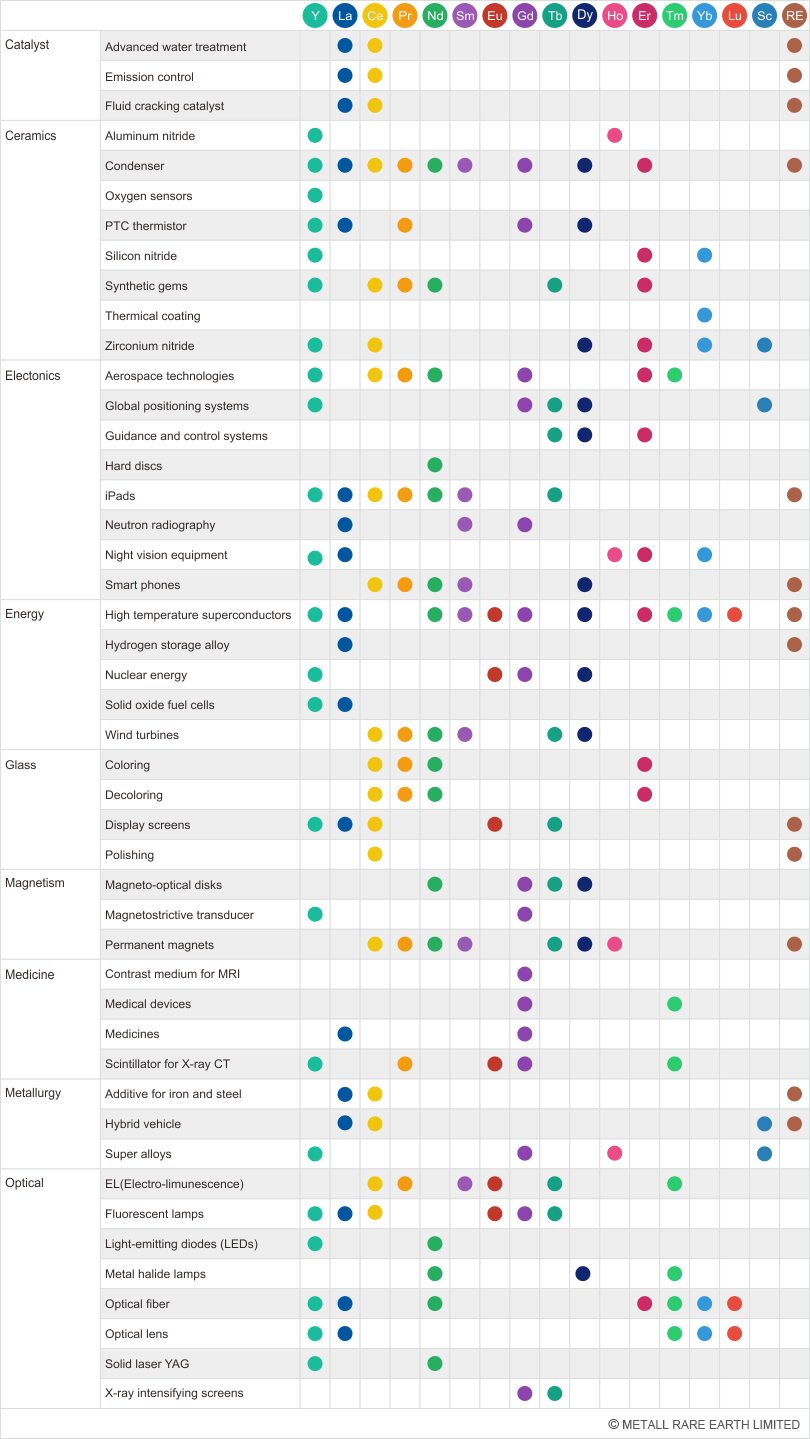| Rare Earths |
| Scandium |
| Yttrium |
| Lanthanum |
| Cerium |
| Praseodymium |
| Neodymium |
| Samarium |
| Europium |
| Gadolinium |
| Terbium |
| Dysprosium |
| Holmium |
| Erbium |
| Thulium |
| Ytterbium |
| Lutetium |
 |
We supply to over 30 countries worldwide, and hold regular stock of common Rare Earth oxides, metals & compounds. For research and samples, we offer prompt delivery to USA, Japan, Korea and fast delivery for the EU & rest of the world.
|
Product List |
This is text of nav-ed item!
This is links of nav-ed item!
|
|
| Home > Industries |
|
Industries
Rare Earths: The key of innovation! |
 |
| "The key of innovation!", the Rare Earth elements have had a unique and important impact on our lives, especially in the industrial age of the twentieth century. This trend is certain to continue in the twenty-first century as research and development efforts uncover new applications for these little known materials in our increasingly high-tech world. The unsaturated 4f electronic structure of rare earth elements makes them have special properties in luminescence, magnetism and electronics, which could be used to develop many new materials such as phosphors, magnetic and magnetostrictive materials, hydrogen storage materials and catalysts. |
 |
Catalyst
Growth in auto catalysts is very strong in response to legislation on lower emission levels, auto-emission converters will be a must for new vehicles in which rare earth is used as a catalyst, thus lowering the consumption of precious metals in the fields. Rare Earth catalyst can raise gasoline production by 5% and increase the capacity of the cracking equipment by 20-30%. Rare earth can also be employed in paints drier and thermal stabilizer for plastics and so on.
Related mostly Rare Earth elements:
Ceramics
Ceramic powders are necessary ingredients in most engineering ceramics, electronic ceramics and ceramic coatings. With telecommunications being one of the largest ceramic industries, dielectric resonators, ceramic filters and multi-layer capacitors are continually being developed to increase performance. Y2O3 stabilized ZrO2, Nd2O3, La2O3 and Y2O3 are used to make different kinds of advanced ceramics.
Related mostly Rare Earth elements:
Electonics
Recent years, technological innovations, especially increasing demand on smart electronics and devices, like iPhone and iPad, resulted in manifold applications using Rare Earths which lead to a steep increase in their demand. Various Rare Earth Oxides and Compounds are applied in a wide variety of electronics such as semiconductors, nickel-metal hydride batteries,
Related mostly Rare Earth elements:
Energy
In energy application, Rare Earth are advantageous because of their relatively low toxicity. Rechargeable lanthanum-nickel-hydride (La-Ni-H) batteries are replacing Ni-Cd batteries batteries in automobiles. Although more expensive, La-Ni-H batteries offer greater energy density, better charge-discharge characteristics, and fewer environmental problems upon disposal or recycling.
Meanwhile, Neodymium iron boron permanent magnets are used in wind turbines and traction motors for electric vehicles, the use of rare earth permanent magnets in these applications is growing due to the significant performance benefits permanent magnets provide.
Related mostly Rare Earth elements:
Glass
Cerium compounds widely used in glass additives and glass-polishing compounds, while Lanthanum doped or Erbium optical glass features high refraction and low dispersion, can efficiently simplify optical system, expand visual angle and minimize lens. Specially in high-tech applications, Rare earth doped fluorochlorozirconate glass ceramics were synthesized, the glass ceramics containing europium can downshift light for solar applications, holmium doping in the glass ceramics yields additional emissions.
Related mostly Rare Earth elements:
Magnetism
The first family of rare earth magnets invented is Samarium-cobalt magnets, Samarium-cobalt has a higher Curie temperature, creating a niche for these magnets in applications where high field strength is needed at high operating temperatures.
Neodymium-iron-boron (NdFeB) magnets are the most powerful permanent magnets available today, and the third generation of permanent magnet invented in the 1980s, has a combination of very high remanence and coercivity, and comes with a wide range of grades, sizes and shapes. Recently years, Dysprosium and Terbium are doped to achieve better performance.
Related mostly Rare Earth elements:
Medicine
Many of the frequently used contrast agents for MRI(Magnetic Resonance Imaging) are based on the Gadolinium, which is paramagnetic. There are many more applications such as MRI magnets, medical lasers, surgical implants, and fluorescent materials for sensors and diagnostics. As advances in areas such as nanotechnology continue to be made, new areas of application for Rare Earths in medicine are sure to open up with their unique properties to be applied to the diagnosis and treatment of medical conditions.
Related mostly Rare Earth elements:
Metallurgy
The Rare Earth ferrosilicon is widely used in metallurgy as the inoculant, nodulizer and deoxidizer to improve the temperature of the molten steel. In recent years, more and more pure Rare Earth metals are applied into manufacturing high performance alloy and superalloys.
Related mostly Rare Earth elements:
Optical
Super pure Rare Earths are widely as dopants in high-concentration optical fibers, With the development of low-loss fibers and the availability of laser pump sources, there has been a renewed interest in rare earth doped glasses in fiber form. High purity grades are also the most important dopants for laser crystals, lens, and optical systems.
Related mostly Rare Earth elements:
|
|